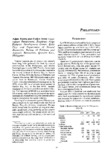Country report: Philippines
- Global styles
- MLA
- Vancouver
- Elsevier - Harvard
- APA
- Help

View/
Date
1982Page views
4,995ASFA keyword
AGROVOC keyword
Taxonomic term
Geographic names
Metadata
Show full item record
Share
Abstract
Natural populations of oysters and mussels have long been gathered for food by coastal communities in the Philippines, and bivalve farming began in early 1900. The first farms were no more than a series of bamboo poles inserted in the muddy bottom of Manila Bay in Bacoor Cavite. In May 1934, the Bureau of Fisheries and Aquatic Resources (BFAR) established a pilot oyster farm in Binakayan, Cavite Province, Luzon, and a lucrative industry soon grew up. By 1950, about 200 ha of private farms existed in Bacoor Bay, but, in the late 1950s, mussels appeared on the farms and threatened the industry. The response of BFAR was to initiate farms for mussels, and the results prompted the establishment of a mussel industry that proved to be at least as lucrative as the oyster industry.
Farming of windowpane oysters (Placuna placenta) began in the late 1940s in the tide flats of Bacoor Bay, the delicate, translucent Placuna shells being used for window glazing and shellcraft. In the early 1970s, however, the bay became increasingly polluted, the stocks could not survive, and they are still not found in the waters of the bay.
Suggested Citation
Young, A., & Serna, E. (1982). Country report: Philippines. In F. B. Davy & M. Graham (Eds.), Bivalve culture in Asia and the Pacific: proceedings of a workshop held in Singapore, 16-19 February 1982 (pp. 55–68). Ottawa: International Development Research Centre.
Type
Conference paperCollections
- Conference Proceedings [298]



